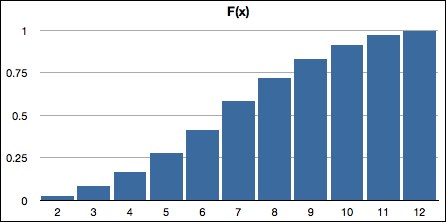For every probability distribution function f(x), there is a corresponding cumulative distribution function (CDF), denoted by F(x) and defined as:

Table 4-3. Dice example
The expression on the right means to sum all the values of f(u) for u ≤ x.
The CDF for the dice example is shown in Table 4-3, and its histogram is shown in Figure 4-6:
|
x |
fX (x) |
|---|---|
|
2 |
1/36 |
|
3 |
3/36 |
|
4 |
6/36 |
|
5 |
10/36 |
|
6 |
15/36 |
|
7 |
21/36 |
|
8 |
26/36 |
|
9 |
30/36 |
|
10 |
33/36 |
|
11 |
35/36 |
|
12 |
36/36 |

Figure 4-6. Dice cumulative distribution
The properties of a cumulative distribution follow directly from those governing probability distributions. They are:
- 0 ≤ F(x) ≤ 1, for every x ∈ X(S)
- F(x) is monotonically increasing; that is, F(u) ≤ F(v) for u < v
- F(xmax) = 1
Here, xmax is the maximum x value.
The CDF can be used to compute interval probabilities more easily that the PDF. For example, consider the event that 3 < X < 9; that is, that the sum of the two dice is between 3 and 9. Using the PDF, the probability is computed as:

But computing it using the CDF is simpler:

Of course, this assumes that the CDF (in Table 4-3) has already been generated from the PDF.